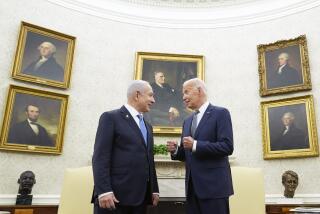Russia Warned on Helping Iran Missile Program
- Share via
WASHINGTON — The Clinton administration has issued a diplomatic warning to Moscow about Russian assistance to Iran’s missile program--aid that could threaten U.S. troops in Saudi Arabia, several Persian Gulf allies and Israel, senior administration officials say.
Intelligence reports indicate that Russia recently transferred to Iran technology for the Russian SS-4 missile, which has a range almost three times greater than that of any missile now in Iran’s arsenal.
The warning was issued during talks last week between Vice President Al Gore and visiting Russian Prime Minister Viktor S. Chernomyrdin.
The transfer basically involved detailed instructions on how to construct the weapon’s delivery system, U.S. sources said. Israeli officials said Tuesday that the transfer also included some parts for an SS-4 missile.
The SS-4, with a range of 1,250 miles, carries a standard warhead that is equivalent to 3,000 pounds of TNT. The Soviet Union, however, once loaded the missile with a 1-megaton nuclear warhead.
Chernomyrdin denied that Moscow had authorized transfer of the giant missile, administration officials said. He acknowledged that such action would amount to a violation of a 1994 pledge by Russian President Boris N. Yeltsin not to engage in further arms sales to Tehran.
Administration officials are speculating about whether the missile technology could have been transferred to Iran from cash-strapped former Soviet arms producers or complexes.
“How it happened is still a gray area. One possibility is that it was beyond the control of government,” a senior administration source said Tuesday.
A well-placed Middle East source added: “The Russian government may not support such an export, but they don’t do enough to stop it. . . . They are not monitoring what is leaving their country.”
Past reports about arms transfers to Iran often have reflected fears rather than reality. But senior U.S. sources said the intelligence evidence on the SS-4 transfer, much of which was presented to the White House by senior Israeli officials and was first reported in the Israeli press last month, is overwhelming.
The Israeli claims matched U.S. intelligence gathered in recent weeks, the U.S. sources said.
The Iranian mission at the United Nations said it was unable to comment on the reports, which it said it had not seen.
The United States has reason to be more concerned about the SS-4 than about Scud missiles with a range of about 320 miles that Iran bought from North Korea, military experts say.
Iran’s acquisition of the SS-4 is being interpreted as a new indication that Tehran is actively seeking a nuclear capability, despite its vehement and repeated denials, according to administration sources and regional experts.
“A missile of that size and accuracy could only be lethal or used effectively with a nuclear weapon or a biological weapon of near-nuclear lethality,” said Anthony Cordesman, co-director of the Middle East program at the Center for Strategic and International Studies.
The SS-4 has a greater range than the missiles in any Mideast country, military experts said.
“It could change the balance of power in the region--if Iran can make the missile operational and if it can obtain those warheads,” Cordesman said. “But those are big ifs.”
Tehran is closer to developing a significant biological weapons payload, he added.
The missile’s limited accuracy makes it more suitable for attacks on large population centers than on more precise targets, military experts said.
The U.S. diplomatic warning reflects broader American concern about the buildup of Tehran’s unconventional weapons at a time of growing tension in the Persian Gulf.
“Iran has concluded that it cannot compete with the United States or other regional powers in conventional strength, so it’s doing two things: proliferating weapons of mass destruction and exploiting every opportunity to find technology or materials for delivery systems required--missiles and aircraft,” Cordesman said.
Iran has also built up a major capacity to threaten traffic through the Persian Gulf, senior administration sources said, deploying troops and anti-ship missiles and developing advanced mines that could be placed in strategic shipping lanes. Iran has also purchased three new Russian submarines.
Iranian officials have denied publicly that Tehran has aggressive intent against any party in the Persian Gulf.
In the run-up to the 18th anniversary of Iran’s revolution this week, they have charged that the United States is the party preparing for confrontation.
In 1995, Washington warned Russia that its plan to build a nuclear reactor in Iran would facilitate Tehran’s nuclear weapons capability.
The administration was also alarmed about the potential impact of Russia’s submarine sale on oil shipments and on the U.S. naval presence in the Gulf.
Russia has become Iran’s largest arms source. As part of past agreements, Moscow admitted last year that it would sell Tehran military equipment worth $1 billion in 1997 and 1998, according to Jane’s Defense Weekly.
More to Read
Sign up for Essential California
The most important California stories and recommendations in your inbox every morning.
You may occasionally receive promotional content from the Los Angeles Times.













